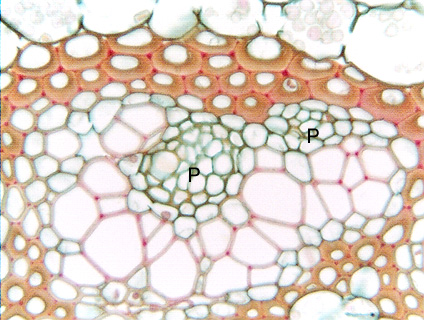 Fig.
11.5-6. Transverse section of Clintonia
borealis (in the lily family, no common name). Rarely, monocot bundles occur
so close together that they more or less form a ring, almost having the
appearance of the eustele of dicots and gymnosperms. But notice that this
“ring” is divided into separate bundles by bundle sheaths. Another
unusual feature here is that the xylem surrounds the phloem on three sides
(all sides except the outer side). Because xylem does not completely encircle
the phloem, these are not amphivasal bundles, but they can be described as
having U-shaped xylem.
Fig.
11.5-6. Transverse section of Clintonia
borealis (in the lily family, no common name). Rarely, monocot bundles occur
so close together that they more or less form a ring, almost having the
appearance of the eustele of dicots and gymnosperms. But notice that this
“ring” is divided into separate bundles by bundle sheaths. Another
unusual feature here is that the xylem surrounds the phloem on three sides
(all sides except the outer side). Because xylem does not completely encircle
the phloem, these are not amphivasal bundles, but they can be described as
having U-shaped xylem.
In
the high magnification, it is easy to distinguish the tracheary elements from
the sheath fibers, due to differences in both wall thickness and wall staining.
In this bundle, a small portion of the phloem is slightly separated from the
main phloem group.
Notice the abundant starch grains in cells of
both the cortex and the conjunctive tissue.